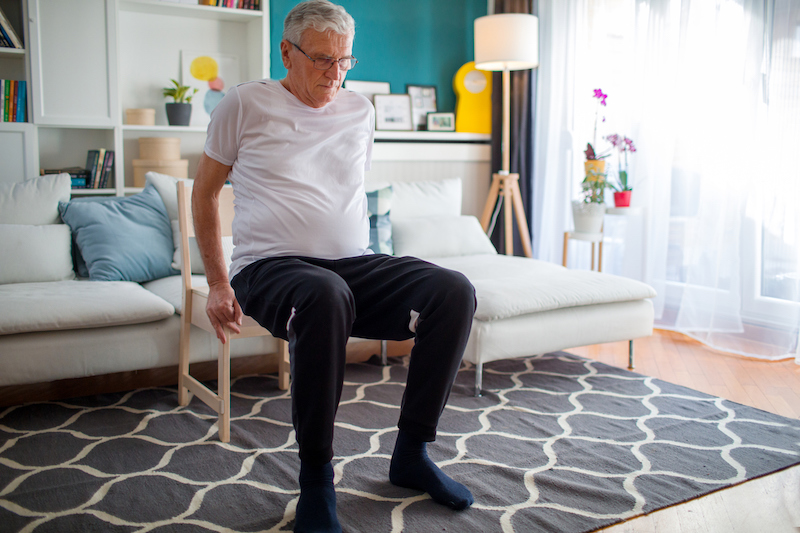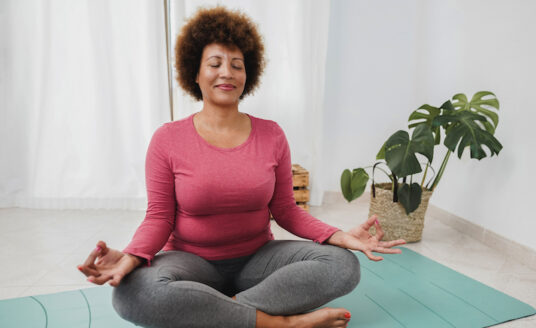Many seniors believe that they cannot exercise because of their age and their decreased mobility. This couldn’t be further from the truth! A lack of mobility does NOT mean you can’t exercise and keep yourself vibrant. In fact, there are plenty of exercises designed to increase or maintain strength, flexibility, cardiovascular health and range of motion that you can perform comfortably and safely in a chair.
If you have poor balance, joint pain, are recovering from a surgery or injury, or simply have not exercised for a long time, using a sturdy chair (without wheels) for support during exercise can help bring back the joy in movement and improve your fitness.
People aged 65 and older are recommended to aim for 150 minutes per week of moderate intensity aerobic activity, as well as two days per week of strength training. However, if you find those recommended levels of exercise difficult to meet, even 15 minutes a day can produce significant benefits!
Exercise should require some exertion, but there is a difference between healthy muscle fatigue and injury. If an exercise causes pain that continues after resting, consider modifying the exercise or switching to something different. After all, you only benefit from the exercises you perform correctly.
Note: Seniors should always consult with their physician before beginning a new exercise program.
Chair Exercises for Seniors
Warm Up
Three to five minutes of warm-up before beginning any exercise session should be sufficient, and arm circles are a great way to start. Sit fully upright in a sturdy chair (without wheels) with your feet flat on the floor. Stretch your arms out to either side and parallel to the floor. Make forward circles using a small, controlled motion, gradually making the circles bigger. Reverse the circles after about 10 seconds.
Seated knee extensions are a great warmup for the lower body. Sit in a chair with your back straight and your arms at your sides. Extend and straighten your right knee, while focusing on squeezing your quadriceps muscle (the muscle at the front of your thigh). Hold for three seconds. Change legs and repeat. Perform as many repetitions as it takes to warm up your leg muscles.
If you’re able, you can also stand, placing your hand on the back of a sturdy chair for support, and march in place.
Dumbbell Curl
While seated in a chair, hold a dumbbell in each hand. Bend your elbows, bringing the dumbbells up to your shoulders while keeping your elbows at your sides. Try to perform 12 repetitions. A curl is a pulling exercise, meaning you are moving the weight toward your body. Use weights or resistance bands that will allow you to perform around 12-15 repetitions.
Dumbbell Press
It’s important to also incorporate some pushing exercises into your routine, such as the dumbbell press, where you move weight away from your body. While seated, hold a dumbbell in each hand. Bend your elbows, bringing the dumbbells in line with your shoulders while keeping your elbows at your sides. Press the dumbbells above your head, then lower the weights to your shoulders. This is one repetition.
If you do not have dumbbells, canned goods or plastic water bottles can also be used for pressing and curling exercises. A couple of sets of 12-15 repetitions is a good start.
Squats With Chair Support
Stand in front of a sturdy chair (without wheels), holding the top for support. Move down into a squat position by pushing your hips backward and bending your knees. Keep your back straight and your chest up. If you cannot perform a full squat, drop down to a half-squat position and then stand back up and repeat. See if you can complete 10 repetitions.
Abdominal Twists
When people say they are working their core, they mean their abdominal muscles. Core strength is important because your abdominal muscles are your base of support. They are crucial in every movement you perform throughout the day, from getting out of bed in the morning to walking in your neighborhood and working in your garden in the afternoon.
To perform this abdominal exercise, sit up straight with your feet flat on the floor. Hold your arms at a 90-degree angle, with your elbows at your sides and your forearms extended in front of you. Rotate your upper torso to the left until you feel a stretch in your stomach area, keeping the rest of your body still. Return to the middle and twist to the right. That’s one repetition. Try for 8-10 reps.
Captain’s Chair
This abdominal exercise is a bit more challenging. Sit up straight in a sturdy chair (without wheels) and grab the edges of the chair seat. Slowly lift your feet off the floor and move your knees toward your chest. Squeeze your abs at the top of the movement, and slowly lower your feet back to the floor. Repeat. Try for 8-10 reps.
Stationary Biking
Riding a stationary bike is great for cardiovascular health. One type of stationary bike, a recumbent bike, enables you to sit in a chair-like seat that has back support, putting little stress on your knees as you pedal. These bikes can come with timers and heart rate monitors, and fully adjustable pedal resistance levels.
Seated Jumping Jacks
Sit up straight on the edge of a sturdy chair (without wheels) and extend your arms down to your sides. Keeping your arms straight, move them up until your hands are above your head. You can clap when your hands meet above your head if you want. Return your arms back to your sides and repeat the motion. You can start slow and then increase your speed. Try for 3 sets of 20 reps each.
Bonus Tip: Add some music! Put together a playlist and move to the music for added enjoyment.
Explore More Chair Exercises for Seniors
The best way to learn a new exercise is to watch someone perform it. SilverSneakers provides videos on how to perform many beneficial chair exercises for seniors.
You can also perform curls and presses using resistance bands to help work your lower body, back, abdominal muscles, shoulders, and legs. Make sure to use proper technique for your safety.
Healthline also provides additional warmup and exercise recommendations that can all be done from the safety of a chair.
Benefits
Chair exercises for seniors can provide you with the same benefits as other forms of activity including:
- Lowering your risk of certain health conditions, including heart disease, stroke, hypertension, and type 2 diabetes
- Improving bone health
- Aiding mobility
- Lowering risk of dementia
- Enhancing range of motion
- Promoting better balance
- Improving quality of life
- Lowering risk of depression
- Improving sleep quality
Regular exercise can also help you to restore confidence in yourself as you watch your physical abilities improve, and if you find someone to exercise with, it can even enhance your social life. Rediscover the joy of movement!
Visit Bethesda’s Health & Wellness blog for more exercise tips.





